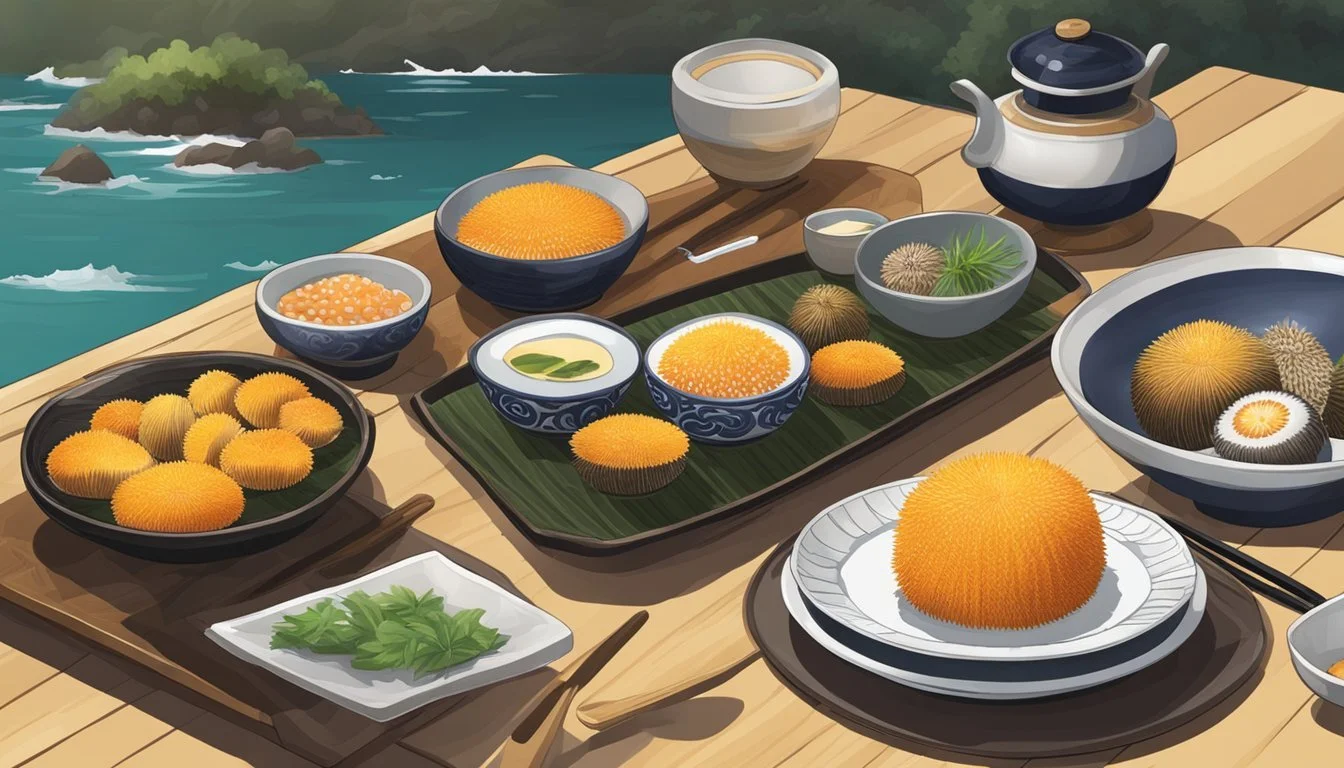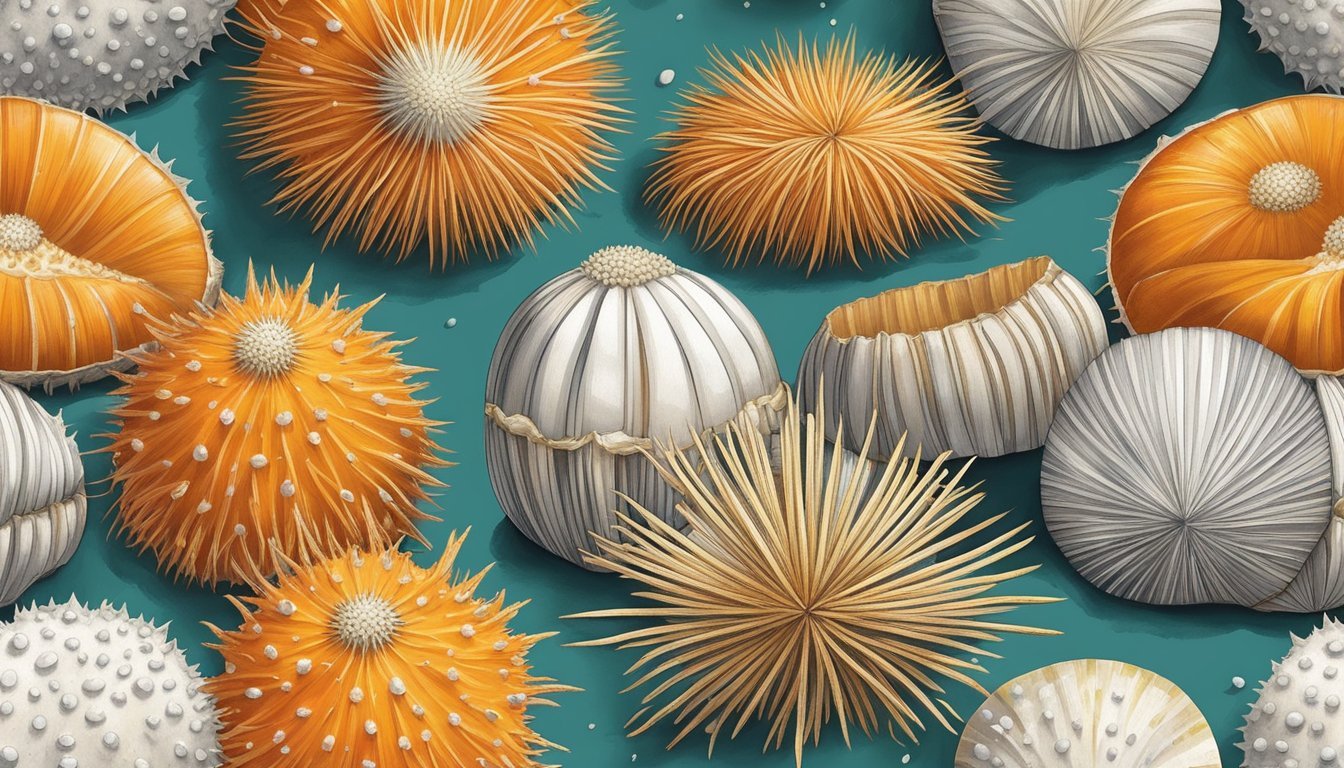Uni The Sea Urchin Delicacy Elevating Japanese Cuisine
Uni is the Japanese term for the edible part of the sea urchin, an aquatic creature found in oceans worldwide. A staple in Japanese cuisine, uni is particularly renowned for its rich, creamy texture and unique taste, often described as a blend of sweetness and umami — a savory flavor that is one of the five basic tastes. Typically a shade of yellow to a deep orange, uni is a sought-after delicacy that is most commonly served in sushi (What wine goes well with sushi?) restaurants, particularly as gunkan maki or "battleship roll," where it is cradled in a strip of nori seaweed atop a bed of seasoned rice.
Not all sea urchins are created equal when it comes to their culinary value. Factors such as the urchin's diet, the season, and the waters in which it lives can all influence the flavor profile of uni. Japanese cuisine places a high value on the subtle differences these factors create. Varieties like Santa Barbara uni from the giant red sea urchin are esteemed for their size, texture, and bright flavor, hinting at the rich diversity available within this single ingredient.
The cultural importance of sea urchin in Japan extends back over a millennium, with the delicacy's history rooted in the Heian period. Uni continues to hold its place as a luxurious item that celebrates the ocean's bounty. Its preparation and consumption are steeped in tradition while remaining open to innovation in contemporary culinary practices, ensuring uni remains a beloved and integral component of Japan's gastronomic identity.
Uni Basics: What Is Sea Urchin?
Uni is essentially the edible part of a sea urchin, an ocean creature known for its spiny exterior and unique culinary offerings. In Japanese cuisine, uni is esteemed as a delicacy, celebrated for its distinct taste and texture.
Sea urchins belong to the echinoderm family, which includes starfish and sand dollars. Spherical in shape and covered with sharp spines, these creatures house a prized component inside their hard shells. Uni refers to the sea urchin's gonads, which are responsible for reproduction. These edible parts are typically a creamy consistency with rich, sea-breeze flavors.
In terms of color and flavor, uni varies considerably. It ranges in hue from pale yellow to deep orange. The color can be indicative of the sea urchin's diet and habitat, with some notations below:
Pale yellow: Often milder in taste.
Rich orange: Noted for its intense, briny flavor.
Uni plays a significant role in Japanese cuisine. It is often served as sashimi or as an ingredient in sushi, such as gunkan maki. The flavor profile of uni is often characterized as a balance of sweet and briny, with a buttery texture that can be described as an umami bomb — it's the savory fifth taste alongside sweet, sour, bitter, and salty.
Diners appreciate uni's fresh, oceanic essence. For the best culinary experience, it should be enjoyed fresh, displaying firmness and bright color without any liquid seepage. Whether enjoyed on its own or as part of a dish, uni provides a flavorful journey through the subtleties of marine gastronomy.
Historical Significance of Uni in Japan
Uni, the Japanese term for sea urchin, holds a prominent place in Japanese cuisine and culture. Steeped in history, its origins as a culinary delicacy in Japan can be traced back over a thousand years. During the Heian period (794-1185), uni was highly valued by the aristocracy, gracing the tables at imperial banquets. It symbolized a luxurious facet of the courtly life and culinary sophistication of the era.
In subsequent years, uni maintained its prestigious status and eventually found its way into the diets of the samurai class during the Edo period (1603-1868). This period marked the beginning of uni's evolution into a more widespread culinary ingredient, particularly in sushi preparation. Uni became a coveted topping in nigiri sushi, its velvety texture and rich, oceanic flavor winning over food aficionados.
Festivals in coastal regions of Japan often celebrate the sea urchin harvest, highlighting its importance to local communities. Such events accentuate uni's role in regional traditions and its contribution to Japan's gastronomical identity.
Period: Heian Period
Significance in Japanese Culture: Delicacy for the aristocracy and royal banquets.
Period: Edo Period
Significance in Japanese Culture: Included in the samurai diet, linked to sushi.
Period: Modern Times
Significance in Japanese Culture: Celebrated in festivals; integral to sushi cuisine.
Today, uni is a staple in contemporary Japanese cuisine, an embodiment of the nation's historical ties to the sea and their reverent approach to its bounties. The appreciation for this ocean delicacy continues, reflecting Japan's enduring connection to its culinary past.
Sourcing Sea Urchin: Regions and Varieties
The global uni market features a variety of sea urchin, with regions like Hokkaido and Santa Barbara emerging as key sources. Each variety presents distinct characteristics appealing to the palette of the seafood (What wine goes well with seafood?) lover.
Hokkaido: A Prime Source for Uni
Hokkaido, located in the northeast of Japan, is renowned for its high-quality sea urchins, particularly Bafun Uni and Murasaki Uni. The cold waters of the region provide an ideal environment for these two types where:
Bafun Uni: It's known for its rich, creamy texture and vivid orange color.
Murasaki Uni: This variety typically has a lighter hue and a slightly more briny flavor.
Santa Barbara: A Western Uni Hub
Santa Barbara has established itself as a western hub for uni, supplying both domestic and international markets. The Santa Barbara Uni is often:
Praised for its sweet and buttery taste.
Comparable in quality to its counterparts in Hokkaido.
Characteristics of Different Uni Types
Different sea urchin types are identifiable by their color, texture, and flavor:
Type: Bafun Uni
Color Range: Vivid Orange
Texture: Creamy
Flavor Profile: Rich and sweet
Type: Murasaki Uni
Color Range: Pale Yellow to Orange
Texture: Slightly firm
Flavor Profile: Briny
Type: Santa Barbara Uni
Color Range: Varies
Texture: Buttery
Flavor Profile: Sweet
Food markets and sushi connoisseurs alike seek these characteristics when selecting uni to ensure a premium culinary experience.
Nutritional Value and Health Aspects
Sea urchin, known as uni in Japanese cuisine, is prized not only for its unique flavor but also for its nutritional profile. Uni is a low-calorie food that's densely packed with high-quality protein—an essential nutrient for muscle building and repair. A 100-gram serving offers a substantial 18.4 grams of protein, contributing to its status as a healthy protein source.
Rich in omega-3 fatty acids, uni supports cardiovascular health. These healthy fats are critical for reducing inflammation and maintaining heart health. Moreover, sea urchin is an excellent source of numerous minerals that play crucial roles in bodily functions:
Calcium: Vital for bone health and muscle function, a serving provides 350 milligrams.
Magnesium: Involved in over 300 biochemical reactions in the body, with 145 milligrams per serving.
Zinc: Important for immune function and wound healing.
The delicacy also contains a significant amount of vitamins, including vitamin A and vitamin E. These vitamins are antioxidants, helping to protect the body from oxidative stress and support skin health.
In summary, uni's nutritional value makes it a healthful choice to include in a balanced diet. Its rich content of proteins, vitamins, omega-3 fatty acids, and minerals underline its beneficial health aspects. With these nutrients, uni is recognized for its contribution to a healthy lifestyle, particularly in the context of a nutrient-rich diet.
Culinary Uses of Uni
Uni, the rich and creamy roe of sea urchins, is a celebrated ingredient in Japanese cuisine. Its unique taste and texture make it a versatile addition to various dishes, ranging from traditional sushi to inventive pasta creations.
Uni in Sushi and Sashimi
In Japanese cuisine, uni is commonly savored in sushi and sashimi. As gunkan maki, a type of sushi, uni is displayed atop a bed of sushi rice, encircled by a strip of nori. The bright color and oceanic flavor of uni deliver an exquisite experience that is both visually and gastronomically pleasing. Sashimi, on the other hand, presents uni in its purest form, allowing its natural flavors to stand out without any interference from other ingredients.
Uni Pasta: Fusing Italian and Japanese Flavors
Uni pasta is an example of the fusion between Italian and Japanese culinary traditions. A dish like uni carbonara showcases a cream sauce mixed with egg yolk, parmesan, dashi, and uni to create a luxuriously creamy texture. The sauce is then tossed with al dente pasta, marrying the hearty Italian pasta traditions with the delicate flavors of Japanese cuisine.
Creative Uni Dishes and Pairings
Chefs are continuously experimenting with uni to create innovative dishes. Uni can be served on toast, as a decadent omelet topping, or even incorporated into complex sauces to enhance other seafood or vegetable-based recipes. The creamy and umami-rich qualities of uni make it an excellent component for inventive food pairings that span various cuisines.
Flavor Profile and Sensory Experience
When indulging in uni, the edible portions of sea urchin, diners are greeted with a distinct flavor spectrum that is both sweet and briny. This delicacy offers a sensory experience that is unique to its marine origins, characterized by an umami flavor that is both profound and complex.
The texture of uni is as striking as its taste—creamy and luxurious, akin to a fine custard. It's a pivotal attribute that contributes to the overall sensory encounter. The creaminess of uni allows it to melt in the mouth, leaving a lingering impression defined by its sweet maritime essence.
Quality: Texture
Description: Creamy and soft, similar to custard
Quality: Taste
Description: Sweet, with a briny sharpness and rich umami undertones.
Uni's distinct flavor and sensory attributes make it a highly revered component in Japanese cuisine. Its ability to convey the depths of the ocean through its creamy texture and complex taste profile stands as a testament to its culinary value.
Preparing and Cooking With Uni
Uni, the edible part of sea urchin, requires careful cleaning and proper storage to maintain its delicate flavor. When cooking, it's often paired with ingredients that complement its rich, briny taste, such as olive oil, garlic, and white wine.
Cleaning and Storing Fresh Uni
Fresh uni should be handled with care to preserve its quality and flavor. The roe should be vibrant in color and free from any unpleasant odor. It's essential to clean sea urchin roe gently under cold running water and remove any shell or debris. For storage, place the cleaned uni in a container layered with a damp paper towel, cover it, and refrigerate. The roe is best enjoyed fresh but can be stored in the refrigerator for a couple of days.
The Process of Making Uni Pasta
Making uni pasta, a sought-after dish for the sea urchin lover, begins with boiling pasta – bucatini is a great choice – in salted water until al dente. While the pasta cooks, one heats olive oil in a frying pan and sautés minced garlic until fragrant. This forms the flavor base to which white wine is added and simmered to reduce slightly. Cooked pasta, along with a bit of the pasta water, is then tossed into the pan with tongs, allowing the flavors to marry. The uni is gently stirred into the pasta, where it lends a creamy, savory character to the dish. A pinch of black pepper can add a subtle heat that complements the uni's richness.
Expert Tips for Uni Preparation
Chefs suggest using uni as a luxurious addition to simple and high-quality ingredients. When cooking, one should:
Keep flavors simple to allow the uni's natural taste to shine. Olive oil, garlic, black pepper, and white wine are ideal companions.
Introduce the uni at the end of the cooking process to avoid overheating, which can cause it to lose its delicate texture and rich taste.
Handle with care using tools like spoons or tongs to preserve the integrity of the roe.
Season with restraint; the salty brininess of uni is itself a natural seasoning agent.
Incorporate expert cooking tips like adding a splash of the pasta boiling water to the frying pan to create a perfectly emulsified sauce.
Pairing Sea Urchin With Beverages
When it comes to sea urchin, known as uni in Japanese cuisine, beverage pairing is key to enhancing the dining experience. The unique taste of uni calls for thoughtful selection of wines and sake to complement its rich, creamy texture and distinct marine flavor.
Wine Pairing: Sea urchin pairs well with a variety of wines. For those who prefer white wine, a crisp Sauvignon Blanc is an excellent choice. Its lightness and acidity can cut through the creaminess of uni, providing a refreshing contrast.
Wine Type: Champagne/Sparkling
Characteristics: Crisp, bubbly
Pairing Reason: Complements creaminess
Wine Type: Sauvignon Blanc
Characteristics: Light, high acidity
Pairing Reason: Cuts through richness
Wine Type: Chardonnay
Characteristics: Buttery, less acidic
Pairing Reason: Matches creamy texture.
For those who might enjoy a bubbly option, Champagne and other sparkling wines with their effervescence are also an excellent match. The bubbles and crispness can elevate the uni's natural flavors.
Sake Pairing: In the realm of Japanese beverages, sake is a traditional and harmonious match for uni. A Daiginjo or Junmai Daiginjo, with its delicate and fruity profile, respects the subtleties of sea urchin. The clean finish of these sakes complements the sweetness and salinity inherent in uni.
Sake Type: Daiginjo
Characteristics: Fruity, refined
Pairing Reason: Enhances uni's subtle flavors
Sake Type: Junmai Daiginjo
Characteristics: Pure, balanced
Pairing Reason: Complements sweetness
When considering pairings, one should consider the preparation of the uni dish, as seasonings and accompaniments may also influence the choice of beverage. Whether one opts for wine or sake, the goal remains the same: to elevate the distinct flavors of uni through a harmonious beverage match.
Purchasing and Price Considerations
When searching for uni, seafood lovers should be aware that the price can vary widely based on quality and origin. Japan is renowned for offering some of the highest quality uni, often found in specialized fish markets and upscale sushi restaurants. The cost can reflect this esteemed status; premium grades of sea urchin gonads command higher prices due to their rich flavor and creamy texture.
In terms of pricing, uni is sold by weight, and the market rate is subject to fluctuations. Here is an illustrative range of what consumers might expect:
Quality: Regular
Price Range Example: $20 - $40 per 100 grams
Quality: Premium
Price Range Example: $50 - $100 per 100 grams
Consumers should note that the highest quality selections are often reserved for gourmet venues and may not be readily available at local markets. When purchasing, one should look for flesh that is firm, with a bright color and no seepage — indicators of freshness and quality.
It is not unusual for certain types of uni, especially those harvested in Japan, to sell for substantially more, reflecting their rarity and culinary standing. Buyers should approach purchases with a discerning eye, opting for product that retains its natural shape and color, often found still crisscrossed in its packaging to maintain integrity until consumption.
Impact on Local Economies and Sustainable Sourcing
The rise in popularity of uni, the edible part of the sea urchin, has significant effects on local economies, particularly in coastal areas where sea urchins are harvested. In regions like Ainan in Ehime Prefecture, Japan, turning what was once seen as a marine nuisance into a prized culinary ingredient has helped to revitalize local industries. Sea urchin harvests have provided a boost to the local economy by creating jobs for fishermen and associated businesses such as processing plants and distributors.
The economic impact can be outlined as follows:
Job Creation: The uni industry sustains fishermen, processing staff, and sellers.
Revenue: Boost to local businesses through domestic and international sales.
However, the increased demand for uni necessitates a focus on sustainable sourcing to ensure that this resource does not become depleted. Sustainable sourcing practices are vital to maintaining the balance of marine ecosystems and supporting long-term economic benefits for the communities involved. Methods to promote sustainability include:
Quotas: Limiting the number of sea urchins harvested to prevent overfishing.
Seasonal Harvesting: Allowing populations to regenerate outside of the fishing season.
Habitat Management: Protecting the kelp forests where sea urchins feed to maintain a healthy environment.
These measures help to ensure that sea urchin populations remain robust and that the local economies that depend on them can continue to thrive without causing long-term ecological damage. It is a delicate balance between reaping the economic benefits and preserving marine life, one that requires ongoing effort and regulation.
The Future of Uni as a Culinary Delicacy
The culinary world continuously evolves, yet certain staples maintain their allure among foodies, diners, and chefs alike. Uni, the edible part of the sea urchin, stands out as one such delicacy in Japanese cooking. Looking ahead, the future of uni as a culinary delicacy appears promising, catering to a growing global palette keen on exploring complex flavors.
Trends among Chefs and Diners:
Chefs are innovating traditional dishes, incorporating uni in unexpected ways beyond sushi to appeal to contemporary diners.
There's an increasing willingness from the dining public to try exotic seafood, positioning uni as a sought-after experience.
Demand and Supply:
The demand for uni is projected to rise, spurred by its unique taste and status.
Responsible sourcing and sustainable harvesting practices will be critical to maintaining a stable supply of high-quality uni.
Culinary Arts and Japanese Cooking Influence:
Culinary schools are placing greater emphasis on diverse ingredients, including uni.
As Japanese cuisine gains popularity, key ingredients like uni will benefit from heightened interest.
Market Predictions:
Gourmet markets are likely to see an uptick in uni sales.
Online platforms and specialty stores are expanding accessibility, making it easier for home cooks to experiment with uni.
In the culinary future, uni is set to captivate new generations of food enthusiasts while retaining its heritage in Japanese cuisine. The continued reverence for this creamy, oceanic treasure suggests that uni's place on the gourmet stage is not just a trend—it's a deep-rooted tradition poised to thrive.









